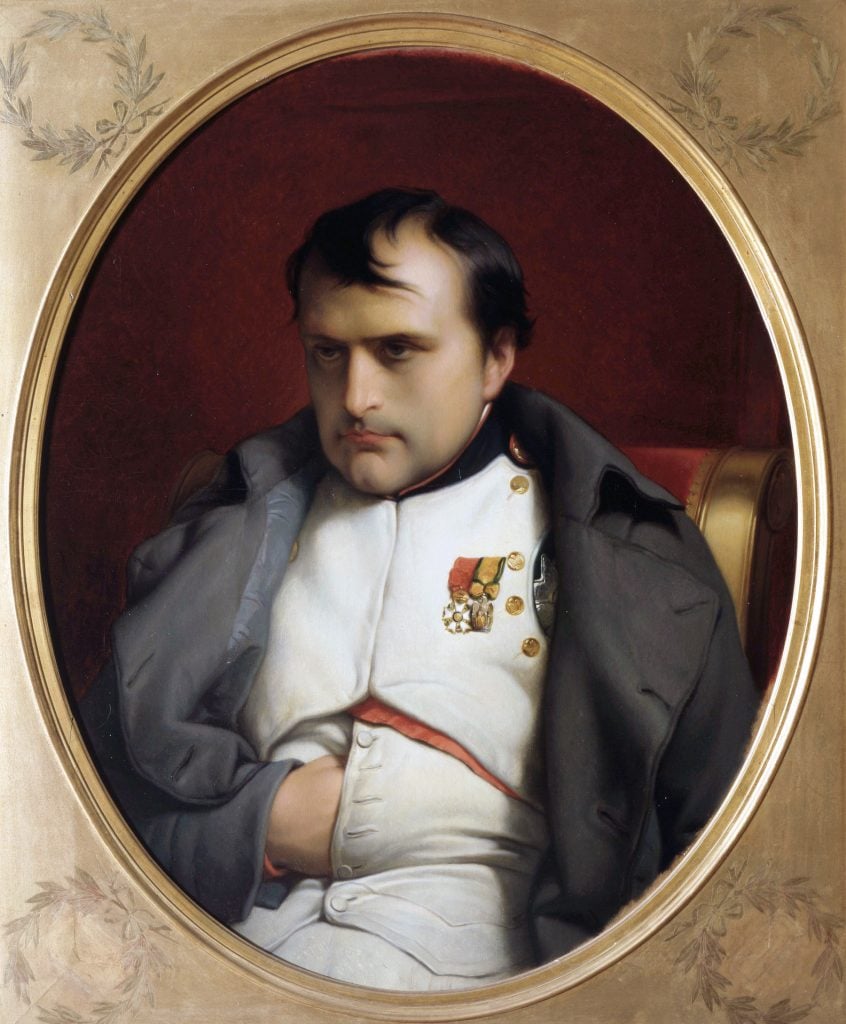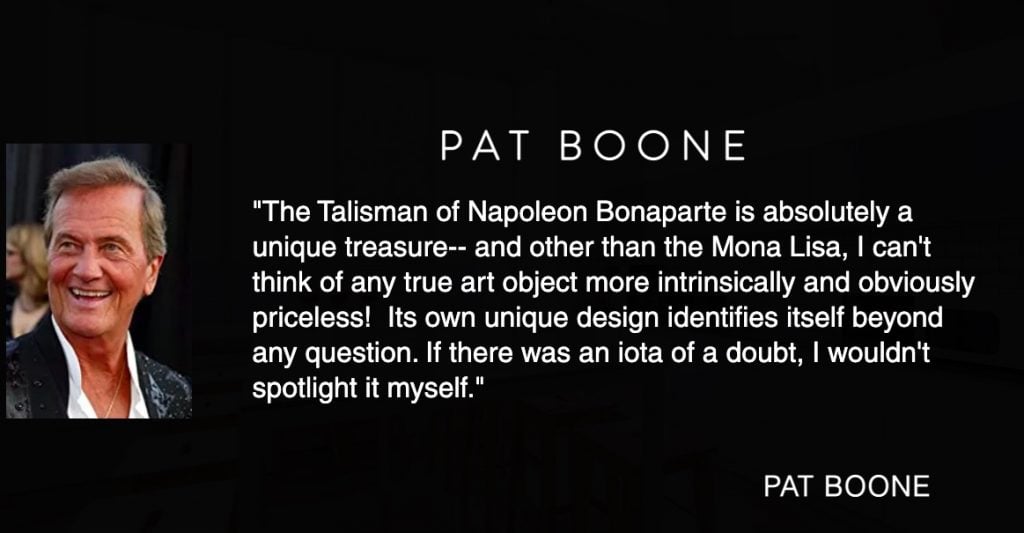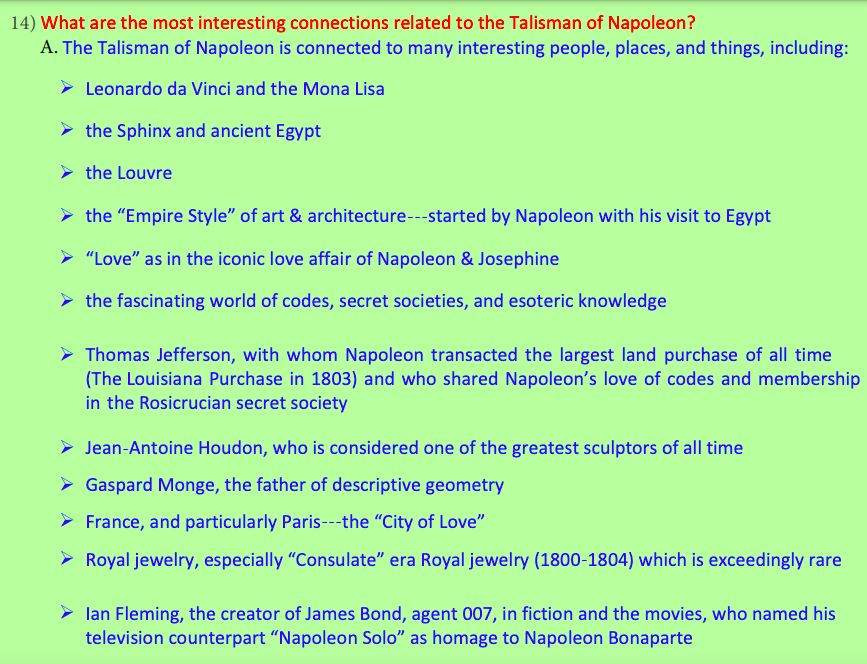Curiosities
The Hilariously Random and Downright Goofy Story of the ‘Talisman of Napoleon,’ Whose Owners Hope to Sell It for $250 Million
Pat Boone is on board.

Pat Boone is on board.

Ben Davis

Curiosities is a column where I comment on the art news of the week, sometimes about stories that were too small or strange to make the cut, sometimes just giving my thoughts on the highs and lows.
Here’s what caught my eye this week…
It is a truly, truly immense bit of art news: the auction of an ultra-rare, jewel-encrusted crystal sphinx once belonging to Napoleon himself. The top estimate? A jaw-dropping $250 million.
Why then, you ask, haven’t you heard of this landmark event? Perhaps because it is being conducted by the Miami-based Auction Company of America, which specializes in estate liquidations. Also perhaps because the existence of a bejeweled “Talisman of Napoleon” was heretofore unknown to art historians, generating some skepticism.
So allow me to introduce you to the evidence in favor of the Talisman’s authenticity and importance, which has impressed noted Napoleonic jewelry experts such as Pat Boone. The Eisenhower-era hit-maker and conservative Christian icon has put his stamp of approval on the sale and will even be present in person at the public unveiling of the Talisman and auction kick-off event on February 4 (the final auction takes place on March 4).

Screenshot of Pat Boone’s endorsement of the Talisman of Napoleon.
The modern story of the Napoleon Talisman, as told in a video on the official Talisman site, begins in 1936, when a Dutch trench digger found it. He brought it with him to the U.S. in fleeing World War II, passed it to his son, who in turn put it on eBay, ultimately trading it for a set of Ping golf clubs to its current owner, G. Randall “Randy” Jensen, “a Mensa member and one of the world’s leading authorities on antique golf memorabilia.”
Because of his acute intelligence, “Randy realized the Talisman had tarot coding 45 minutes into his initial examination.” He then embarked upon a six-year mission to unlock the symbols coded into the patterns of gems in the bibelot, 114 in all.
The results led Jensen to his belief that it was once the personal talisman of Napoleon Bonaparte. These findings are laid out in a 120-page research document and summarized in a 15-minute video in which Jensen decodes the details of the relic.
Much of Jensen’s evidence hinges on enumerating features of the Talisman (e.g. 3 ribs on the Sphinx) and connecting these to Tarot-card symbolism or other alpha-numeric codes (3 is the number of the “Empress” card). There are many passages in the “authentication report” like this:
[T]here are 114 precious stones plus the quartz crystal sphinx. This can be expressed as “114 +1.” The centered “14” represents the 14th letter of the alphabet, “N” for Napoleon. There is a “1” on either side of the “14” (1-14-1). 1+1 = “2” for the second letter of the alphabet, “B” for “Bonaparte.” Thus, the sum of all the jewels in this work of art is coded “Napoleon Bonaparte.”
On the basis of the crystal sphinx’s pinhole eyes, Jenson further suggests that renowned neoclassical sculptor Jean-Antoine Houdon could have been involved in its production. He also thinks that the face of the sphinx was likely inspired by Leonardo da Vinci’s Mona Lisa.
Following detours into the lore of Dan Brown’s The Da Vinci Code and the Rosicrucian symbolism of the original 13 U.S. colonies, the document’s FAQ section includes the following question, which might also be on your mind by now: “Are there historical documents that link this jeweled sphinx to Napoleon Bonaparte?”
Answer: “None that have been found. It stands to reason that any documentation relating to the creation of the Talisman of Napoleon would have been intentionally destroyed to preserve its secrets.”

Screenshot of the FAQ page of the “Authentication Report” listing valuable associations of the Talisman.
Given the lack of document evidence, what makes Jensen so sure he has the goods, then?
Aside from Pat Boone, Jensen has a few other experts on his side. One cited in the report document is “Stephen S. Mehler, M.A,” director of the self-directed Land of Osiris Research Project and author of a book that claims the pyramids served as energy transmitters rather than tombs. He says he’s convinced.
Another is mathematician Shih-Chuan Cheng of Omaha’s Creighton University, who runs the odds that the many numerological and Tarot references Jensen has turned up are coincidences, and declares that to be a statistical impossibility. (The Talisman’s official website notes, “As a hard science, mathematics, while seldom used in art verification, is a strong component of any good business and an essential cornerstone of the banking and finance industries.”)
Finally, on the basis of this probability analysis, a third expert, lawyer David C. Nelson, provides a letter to say that the authenticity of the Talisman would stand up in a court of law. In fact, Nelson’s claim is bigger than that, potentially revolutionizing the field of art authentication as a whole. He opines that “mathematical certainty has replaced the need for provenance to authenticate an antiquity.”
As for the very pricey valuation of $150 million to $250 million—where did that come from? “A number of experts.”
A sponsored content interview with “the team at Napoleon’s Talisman” on the website of Barnabys magazine asks the question of how they arrived at such a sum. The answer comes down to the fact that people who have looked at it have called it “priceless,” and Napoleon is very famous:
Ask someone right now: who is the prime minister of (name a country) and they probably won’t know! Ask them who was the most famous emperor in the history of France and you’ll get an immediate answer!
This Talisman is unique. There is only one like it. And it has a personal connection to Napoleon that has no equal. Only one person, museum, organization or society on this planet will be able to lay claim to this incredibly rare antiquity. It’s an investment that can only increase in value.
Last but not least, besides the mathematical certainty of being associated with Napoleon, is there any other reason to covet this artifact, if you are the kind of person with a loose quarter-billion dollars to drop?
Why yes—yes!—there is. Yet another online video makes the case that Napoleon believed in luck, and that every owner of the Talisman has always had good luck, from Napoleon conquering most of Europe to G. Randall Jensen himself becoming “the most successful wood shaft golfer of his era.”
Whether the mysterious Talisman’s powers of good fortune will help Jensen realize its breath-taking auction hopes remains to be seen. So far it has attracted some small buzz in the jewelry community (see this video from Gemstones.com to get a flavor), but little that is willing to take Jenson’s heterodox methods at face value.
The Talisman goes on view tomorrow in a special invite-only event at the PGA National Resort in Palm Beach Gardens, Florida. In addition to Pat Boone, a slew of famed golfers will be on hand, including Jack Nicklaus, who is quoted in a press release about the event as saying, “I found the [talisman] story fascinating, including the ties it has to golf and golf history.”
And that about sums it up. No matter what happens—what a story!